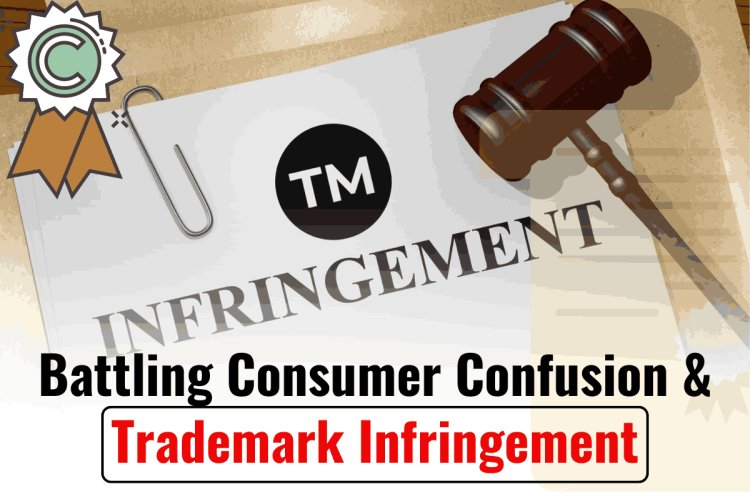Battling Consumer confusion & trademark infringement
In the fiercely competitive landscape of modern commerce, the battle to preserve brand integrity and protect against consumer confusion and trademark infringement has become more challenging than ever. With the proliferation of online marketplaces, social media platforms, and global supply chains, companies face a constant threat to their trademarks and the potential erosion of consumer trust. In this article, we delve into the multifaceted nature of consumer confusion and trademark infringement and explore effective strategies for companies to combat these threats and safeguard their brand identity.

Introduction:
Consumer confusion occurs when consumers are unable to differentiate between products or services due to similarities in branding elements, such as logos, packaging, or slogans. This confusion can result in consumers making unintended purchases or forming negative perceptions of a brand, leading to loss of sales and damage to the brand reputation.
Trademark infringement, on the other hand, occurs when a party uses a trademark that is identical or similar to a registered trademark without authorization, thereby infringing upon the rights of the trademark owner. This unauthorized usage can dilute the distinctiveness of the original trademark, confuse consumers, and undermine the market position of the rightful owner.
Challenges in Battling Consumer Confusion and Trademark Infringement
Several factors contribute to the complexity of combating consumer confusion and trademark infringement:
- Globalization: The expansion of global markets has made it easier for counterfeiters and infringers to operate across borders, exploiting differences in regulatory frameworks and enforcement mechanisms to evade detection and prosecution.
- Sophistication of Counterfeit Operations: Advances in technology, such as 3D printing and digital imaging, empower counterfeiters to produce increasingly convincing replicas of branded products, blurring the lines between authenticity and counterfeit.
- E-commerce Platforms: Online marketplaces provide a convenient platform for counterfeiters to sell counterfeit goods bearing infringing trademarks, often under the guise of anonymity. The sheer volume of listings and transactions on these platforms makes it challenging for brand owners to monitor and enforce their rights effectively.
- Social Media: Social media platforms have become fertile ground for unauthorized usage of trademarks, with users freely sharing images, videos, and content without regard for intellectual property rights. The viral nature of social media amplifies the reach of infringing content, making it difficult for brand owners to contain the damage.
- Emerging Technologies: Advances in technology, such as 3D printing and digital imaging, have made it easier and cheaper for counterfeiters to replicate trademarks with precision, blurring the line between genuine and counterfeit products.
The Anatomy of Consumer Confusion and Trademark Infringement
Consumer confusion arises when individuals encounter products or services that bear striking resemblances to established brands, leading to uncertainty regarding the authenticity or origin of the goods in question. This confusion can manifest in various forms, including mistaken purchases, diminished brand perception, and even potential health and safety risks associated with counterfeit products.
Trademark infringement, on the other hand, involves the unauthorized use of protected trademarks, logos, or brand identifiers by third parties. Whether intentional or inadvertent, such infringements dilute the distinctiveness of the original brand, compromise market share, and tarnish brand reputation.
Strategies for Combatting Consumer Confusion and Trademark Infringement
Despite these challenges, companies can adopt proactive strategies to protect their brand integrity and combat consumer confusion and trademark infringement:
- Trademark Registration and Enforcement: Registering trademarks with relevant authorities provides legal protection and establishes a clear framework for enforcement actions against infringers. Companies should regularly monitor trademark databases for unauthorized registrations and take prompt legal action to enforce their rights.
- Brand Monitoring and Surveillance: Implementing robust brand monitoring systems allows companies to track mentions of their brand and trademarks across various channels, including online marketplaces, social media platforms, and websites. Automated monitoring tools coupled with manual oversight enable companies to detect instances of infringement and take swift action to address them.
- Collaboration with Law Enforcement: Building strong partnerships with law enforcement agencies facilitates the investigation and prosecution of trademark infringement cases. Companies should provide law enforcement authorities with timely and actionable information, such as evidence of counterfeit goods or unauthorized usage of trademarks, to support enforcement efforts.
- Consumer Education and Awareness: Educating consumers about the risks associated with counterfeit goods and trademark infringement helps raise awareness and foster a sense of responsibility among consumers. Companies can leverage marketing campaigns, social media outreach, and educational initiatives to inform consumers about the importance of purchasing authentic products from authorized retailers.
- Strategic Brand Protection Measures: Implementing security features, such as holograms, serial numbers, or tamper-evident packaging, helps deter counterfeiters and enhance the authenticity of genuine products. Companies can also employ blockchain technology to create immutable records of product authenticity and traceability throughout the supply chain.
- Leveraging Legal Remedies: Pursuing legal remedies, such as cease and desist letters, injunctions, and damages claims, against infringers sends a strong message that trademark infringement will not be tolerated. Companies should engage experienced legal counsel to navigate the complexities of intellectual property law and enforce their rights effectively.
- Engaging with Industry Associations: Collaborating with industry associations and trade organizations enables companies to share best practices, exchange information, and advocate for stronger intellectual property rights protection. Participating in industry initiatives, such as anti-counterfeiting task forces or awareness campaigns, amplifies collective efforts to combat trademark infringement.
Conclusion: Protecting Brand Integrity in a Digital Age
In conclusion, battling consumer confusion and trademark infringement requires a multifaceted approach encompassing legal, technological, and strategic measures. By registering trademarks, implementing brand monitoring systems, collaborating with law enforcement, educating consumers, deploying security features, leveraging legal remedies, and engaging with industry associations, companies can effectively protect their brand integrity and preserve consumer trust. In an increasingly interconnected and digitized world, safeguarding trademarks is not only a legal obligation but a strategic imperative for companies seeking to thrive in the global marketplace. As custodians of their brand heritage, companies must remain vigilant in their efforts to combat trademark infringement and uphold the integrity of their trademarks for generations to come.












